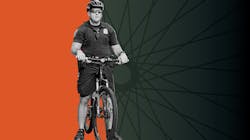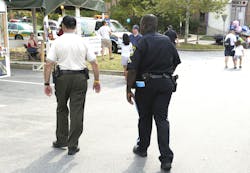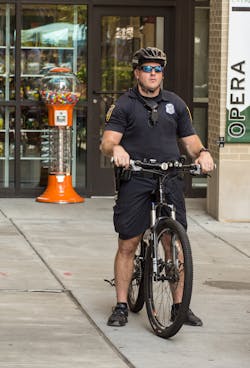Out of the Patrol Vehicle
Foot patrol
Nothing gets officers face to face with the public like foot patrol. The officers are right there in the neighborhood, approachable and able to go anywhere along footpaths, etc. Yes, that said “officers,” as it’s generally safer to have two officers rather than one. While many agencies use the single-officer patrol vehicle, when using foot patrol a lone officer might not be easy to find by backup officers when needed and he might be someplace they can’t get to without traveling some distance on foot themselves. Because of the variety of circumstances that can hinder timely backup arrival for officers on foot patrol, it’s just a better idea to assign foot patrol to officers in teams.
Another challenge for officers on foot patrol is the weather. While it’s easy to look at a weather report and the latest forecast (best guess) and then dress accordingly, no one likes to walk around in the rain, deep cold or frozen precipitation. If the point of foot patrol is to have the officers actually patrol, recognize that such activity is severely restricted or minimized if the weather is ugly enough. (Commanders take note: If you put an officer on foot patrol when the weather is unfriendly it can be viewed as punitive and create morale issues.)
Fitness levels also need to be taken into consideration when assigning officers for foot patrol. While it’s unthinkable that any officer in uniform would be so unfit as to not be able to walk around on patrol for a shift, we can likely all think of some officer we know (or know of) that such applies to. The other side of that coin is that assigning an officer who needs to increase his/her fitness levels to foot patrol is a sure way to increase their daily activity levels and hep them get in shape. Keep in mind that they may still experience circumstances that challenge their fitness levels, just as they could if they were patrolling in a vehicle.
Before you assign officers to a foot patrol beat, take all of the above into consideration. Before they go out, make sure they are properly equipped. For instance, being on foot patrol on day shift doesn’t mean a flashlight won’t be needed. They should still have one. Their radio should be fully charged and there should be a method for them to get a new battery if, for whatever reason, the one they have goes dead. Protection from the elements (a hat at minimum) and hydration need to be taken into consideration. And after a full shift on their feet, they will certainly notice if there’s a deficiency in their footwear. Make sure they know they’ll be on foot patrol before they show up for the shift so they can insure their foot comfort accordingly.Bicycle patrols
Being assigned to a bicycle unit should be preceded by the officer attending the appropriate training program. Riding a bicycle for patrol is a far cry from mountain biking, bicycle racing, or riding a bicycle for cardio training. Patrol concerns, tactics, techniques, bicycle maintenance and more are all part of the training program and it should be completed before the officer goes out for his/her first day on bicycle patrol.
While officers on foot patrol can walk around in the rain or snow, bicycle officers shouldn’t be expected to do such. Bicycle patrol should be considered a fair weather assignment. That said, officers may occasionally (and accidentally) get caught in the rain so having a rain jacket with them isn’t a bad idea. A plan should be in place for what the bicycle patrol officers will do if weather cancels their scheduled riding patrols. As backup for the time will they report to a training evolution? Or might they go out on vehicle patrol in a hot spot? Make sure their time is planned if the weather is questionable.
Just as with foot patrol, bicycle patrol should be done in pairs. The officers who will be assigned to patrol together should train together or at least have opportunity to discuss any concerns before going out on patrol. Being on bicycles side-by-side does not automatically make them think the same way. They need to know how each other will react to certain situations, etc.
The combination
In an ideal world, it might be best to have bicycle patrol officers equipped so they can, as appropriate, park the bikes and go on foot patrol. For example, patrolling a park can mean riding around all the paths and common areas, but then their presence can be leveraged to greater impact by having them park the bikes and walk around the more populated areas like playgrounds or rides. Such would mean having proper locks to secure the bikes and making sure that anything carried on the bike in saddlebags, etc. is secured properly.
When you look at both foot patrol and bicycle patrol, the potential value is easy to see. The officers can go places that officers in patrol vehicles can’t. They can get face to face with citizens, kneel down to get face level with children, engage with business owners and more. The officer in person is far more noticed and stands a greater chance of creating a positive impression than the officer driving by in the sedan or SUV. For both types of patrol, though, there is an equipment component that needs to be considered, and for bicycle patrols the training component needs to be acknowledged and completed. When utilized properly with planning and strategy, both types of patrol can be invaluable when it comes to building a rapport with the community you serve and that’s always a good thing. As a final thought, having citizen “ride-alongs” with bicycle patrol can be fun and engaging, but proper policies must be in place and well communicated.
About the Author
Lt. Frank Borelli (ret), Editorial Director
Editorial Director
Lt. Frank Borelli is the Editorial Director for the Officer Media Group. Frank brings 25+ years of writing and editing experience in addition to 40 years of law enforcement operations, administration and training experience to the team.
Frank has had numerous books published which are available on Amazon.com and other major retail outlets.
If you have any comments or questions, you can contact him via email at [email protected].



